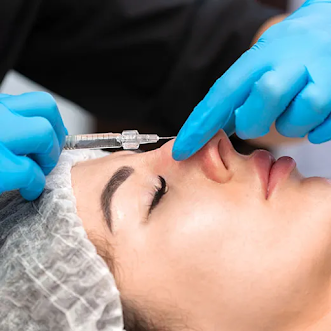Is Liquid Rhinoplasty Suitable for Everyone?
Liquid rhinoplasty, also known as non-surgical rhinoplasty, has become an increasingly popular option for individuals looking to enhance their nasal appearance without undergoing traditional surgery. This procedure involves the injection of dermal fillers into the nose to achieve a more refined or symmetrical appearance. However, like any cosmetic treatment, it's not suitable for everyone. In this guide, we'll explore the factors that determine whether liquid rhinoplasty is a viable option for you.
Understanding Liquid Rhinoplasty
Liquid Rhinoplasty in Dubai uses injectable fillers to alter the shape and contour of the nose. Commonly used fillers include hyaluronic acid, calcium hydroxyapatite, and poly-L-lactic acid. These substances are designed to add volume, smooth out irregularities, and improve the overall appearance of the nose. Unlike surgical rhinoplasty, liquid rhinoplasty does not require incisions or anesthesia, making it a less invasive alternative.
Benefits of Liquid Rhinoplasty
Minimal Downtime: Unlike traditional rhinoplasty, which requires significant recovery time, liquid rhinoplasty often involves minimal downtime. Most patients can resume their daily activities immediately after the procedure.
Reversibility: One of the key advantages of liquid rhinoplasty is its reversibility. If you're unhappy with the results, the effects of the fillers can be adjusted or dissolved using an enzyme called hyaluronidase, specifically for hyaluronic acid-based fillers.
Quick Results: Results are visible immediately after the procedure, allowing patients to see the changes in real-time. This instant gratification is a significant draw for many individuals.
Lower Risk: Because the procedure is non-invasive, it generally carries fewer risks compared to traditional surgical rhinoplasty. There are no incisions, which reduces the risk of infection and scarring.
While liquid rhinoplasty offers many benefits, it is not suitable for everyone. Several factors can influence whether this treatment is the right choice for you.
Nasal Anatomy
The success of liquid rhinoplasty heavily depends on the current shape and structure of your nose. Individuals with certain nasal conditions or anatomical concerns may not be ideal candidates.
Severe Nasal Deformities: If you have significant nasal deformities, such as a pronounced dorsal hump or severe asymmetry, liquid rhinoplasty may not provide the desired results. Surgical rhinoplasty might be a better option in such cases.
Nasal Breathing Issues: Liquid rhinoplasty is not designed to address functional issues such as breathing difficulties or structural problems within the nasal passages. If you have these concerns, a surgical approach might be necessary to achieve functional and aesthetic improvements.
Skin Type and Texture
The condition of your nasal skin can affect how well the filler integrates and the final appearance of your nose.
Thin Skin: If you have very thin skin on your nose, there is a risk that the fillers may be more noticeable or create lumps. A skilled practitioner can mitigate this risk, but it's essential to discuss your skin type and concerns before the procedure.
Previous Scarring: Scarring from past injuries or surgeries can affect the outcome of liquid rhinoplasty. The presence of scar tissue might influence how well the filler settles and the overall aesthetic result.
Expectations and Goals
It's crucial to have realistic expectations about what liquid rhinoplasty can achieve. Understanding the limitations and setting achievable goals will help ensure that you are satisfied with the results.
Cosmetic Enhancements: Liquid rhinoplasty is effective for making subtle improvements, such as smoothing bumps or refining the nose's shape. However, it may not be suitable for individuals seeking dramatic changes.
Temporary Nature: The results of liquid rhinoplasty are temporary, typically lasting between 6 to 12 months, depending on the type of filler used. If you're looking for permanent results, surgical rhinoplasty might be more appropriate.
Health and Medical History
Your overall health and medical history play a significant role in determining whether you are a suitable candidate for liquid rhinoplasty.
Allergies and Sensitivities: Some individuals may have allergies or sensitivities to certain fillers or anesthesia used during the procedure. It's important to disclose your full medical history and any known allergies to your practitioner.
Autoimmune Conditions: People with autoimmune conditions or certain chronic health issues may need to avoid or be cautious with injectable treatments. Consulting with a healthcare provider is essential to ensure that liquid rhinoplasty is safe for you.
Consulting with a Qualified Practitioner
The success and safety of liquid rhinoplasty depend significantly on the skill and experience of the practitioner performing the procedure. It's crucial to choose a qualified and experienced professional who specializes in non-surgical aesthetic treatments.
Choosing the Right Practitioner
Experience and Expertise: Look for practitioners who have extensive experience with liquid rhinoplasty and a proven track record of successful outcomes. Check their credentials and ask for before-and-after photos of previous patients.
Personalized Consultation: A thorough consultation is essential to assess your suitability for liquid rhinoplasty. During this consultation, the practitioner should evaluate your nasal anatomy, discuss your goals, and explain the potential risks and benefits of the procedure.
Safety and Hygiene: Ensure that the clinic adheres to strict safety and hygiene standards. The use of sterile equipment and adherence to proper protocols is crucial for minimizing risks and achieving optimal results.
Conclusion
Liquid rhinoplasty offers a less invasive alternative to traditional rhinoplasty, with benefits such as minimal downtime and immediate results. However, it is not suitable for everyone. Factors such as nasal anatomy, skin type, expectations, and overall health play a significant role in determining whether this procedure is right for you.
Before deciding on liquid rhinoplasty, it's essential to consult with a qualified practitioner to discuss your individual needs and goals. By carefully evaluating these factors and choosing the right professional, you can make an informed decision about whether liquid rhinoplasty is the best option for enhancing your nasal appearance.



Comments
Post a Comment